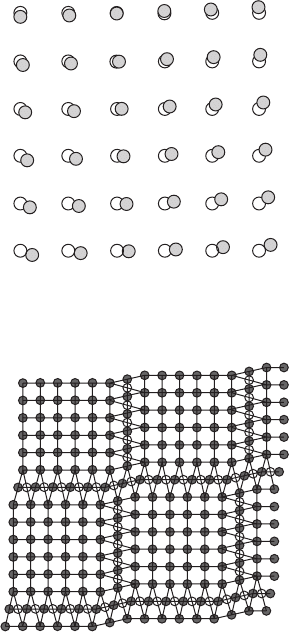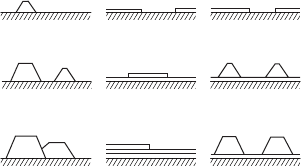Gersten J.I., Smith F.W. The Physics and Chemistry of Materials
Подождите немного. Документ загружается.


THIN FILMS, INTERFACES, AND MULTILAYERS 333
There exist a set of numbers m
1
,n
1
that make G
m
1
,n
1
³ K
21
and another pair m
2
,n
2
that make G
m
2
,n
2
³ K
31
. Thus both K
21
and K
31
are provided by the structure. In the
reference cited above, the values used for the structural parameters were L D 10.7
µm
and C D 0.23.
W20.9 Graphite Intercalated Compounds
Graphite consists of graphene layers of sp
2
-bonded carbon rings arranged in the
stacking sequence ABAB... and separated by 0.335 nm, which is substantially larger
than the nearest-neighbor distance of 0.142 nm. The in-plane lattice constant of the
hexagonal sheet is 0.246 nm. The layers are only weakly bound together by van der
Waals forces. It is possible to insert foreign atoms and molecules in the interlayer
region to form graphite intercalated compounds (GICs). It is found that the atoms
intercalate in well-defined stoichiometric ratios, forming compounds such as KC
24
.In
one type of arrangement one layer of intercalate is followed by n graphene layers, as
illustrated in Fig. W20.4a.Thisiscalledann-stage GIC. For example, KC
24
can exist
as a two-stage compound KC
12ð2
or a three-stage compound KC
8ð3
.Valuesofn up to
8, or higher, are not uncommon. In other compounds there may be several intercalate
layers, followed by n graphene layers. In still other situations the intercalates may form
islands arranged in an array interspersed in the graphite structure (the Daumas–Herold
domain structure). This is illustrated in Fig. W20.4b.
The distance between successive intercalate layers, d
c
, depends on the degree of
staging. Different forms of ordering are found in the GICs. The intercalated layers
could either be commensurate or incommensurate with the host lattice. The graphene
layers could either maintain the ABAB... . stacking sequence or adopt some other
sequence, such as AB/BA/AB/BA/... (where a slash denotes an intercalated layer).
The intercalate could exist as an ordered two-dimensional crystal, a disordered glass,
or even a liquid.
The intercalated atoms and molecules may act as either donors or acceptors. In
either case, carriers are injected into the " bands of the graphene sheet. Typical donors
are the alkali metals, which form GICs such as LiC
6
,LiC
12
,LiC
18
,KC
8
,KC
24
, ... ,
d
(b)(a)
Figure W20.4. Graphite intercalated compounds: (a) n D 5 stage compound; (b) island inter-
calation.

334 THIN FILMS, INTERFACES, AND MULTILAYERS
KC
72
,RbC
8
,RbC
24
or CsC
8
,andCsC
24
. Acceptor compounds are C
10
HNO
3
,C
14
Br,
or C
16
AsF
5
. Note the convention of placing the chemical symbol for the donors to the
left of the carbon and the symbol for acceptors to the right.
Staging results from the interplay of various microscopic forces. Charge transfer is
brought about by the difference in chemical potentials between the graphite and the
intercalate. This, by itself, lowers the energy of the system. The Coulomb interaction
between the layers, partially screened by the mobile carriers in the graphite, is important
in establishing the staging. Elastic interactions are also involved, since the layer spacing
of the host lattice is altered to accommodate the intercalated layer. One of the early
attempts
†
at describing the system theoretically involved the introduction of the model
internal energy:
U
N
0
D t
i
i
u
2
i
2
i
C
1
2
ij
0
V
ij
i
j
,W20.48
where N
0
is the number of intercalation sites in a layer and
i
is the fractional occu-
pancy of the ith layer, a number between 0 and 1. The first two terms represent
the interaction of the intercalate with the host, and the bonding of the intercalate
to form a two-dimensional solid, respectively. The third term describes the screened
Coulomb energy and is positive. The parameters V
ij
are taken to be of the form
V
ij
D V/2jz
ij
j
˛
,wherez
ij
is the interplanar distance. This form is suggested by
making a Thomas–Fermi analysis of the screening for large n. The quantities t, u, V,
and ˛³ 5 parametrize the theory.
The entropy for a given layer is determined by partitioning N
0
i
intercalate atoms
among N
0
sites. Since there are W
i
D N
0
!/[N
0
i
!N
0
N
0
i
!] ways of doing this,
the layer entropy is, by Stirling’s approximation,
S
i
D k
B
ln W
i
Dk
B
N
0
[
i
ln
i
C 1
i
ln1
i
].W20.49
The Helmholtz free energy for the system is
F
N
0
D t
i
i
u
2
i
2
i
C
1
2
ij
0
V
ij
i
j
C k
B
T
i
[
i
ln
i
C 1
i
ln1
i
].
W20.50
Only the layers with nonzero
i
contribute to F. The chemical potential for the ith
layer is given by
0
i
D
1
N
0
∂F
∂
i
D t u
i
C
j
0
V
ij
j
C k
B
T
[
ln
i
ln1
i
]
.W20.51
Setting all the chemical potentials equal to 0 leads to the set of coupled equations
i
D
1
1 C e
ˇtu
i
C
j
0
V
ij
j
0
.W20.52
†
S. A. Safran, Stage ordering in intercalation compounds, H. Ehrenreich and D. Turnbull, eds., Solid State
Physics, Vol. 40, Academic Press, San Diego, Calif., 1987, p. 183.
THIN FILMS, INTERFACES, AND MULTILAYERS 335
For a given set of staging occupancies it is possible to obtain 0T, F, and the other
thermodynamic variables.
Further refinements in the theory have evolved over the years. Interest in GICs
stems largely from the fact that their electrical conductivity is high and may be varied
in a controlled way by changing the stoichiometry.
Graphite fluorides (CF)
n
have been used as cathodes in lithium batteries. By itself,
(CF)
n
is a poor electrical conductor, so it is often combined with a good electrical
conductor such as graphite. The anode is made of lithium. Such lithium batteries
have high specific energy (360 WÐh/kg) and a high voltage (3 V). The material (CF)
n
is a stage 1 compound with every C atom bonded to a fluorine. The layers alter-
nate in the sequence CFCFCF... . The lattice constants are a D 0.257 nm and c D
0.585 nm.
Other GICs that may potentially be used as cathodes have intercalant anions such as
PF
6
,AsF
6
,andSbF
6
. The obstacle to their use is the lack of a suitable electrolyte.
Superconductivity is also observed in GICs (see Chapter W16).
REFERENCES
Critical Thickness
Freund, L B., and W. D. Nix, Appl. Phys. Lett., 69, 173 (1996).
Ionic Solutions
Borukhov, I., D. Andelman, and H. Orland, Phys. Rev. Letters., 79, 435 (1997).
Solid-Electrolyte Interface
Morrison, S. R., Electrochemistry at Semiconductor and Oxide Metal Electrodes, Plenum Press,
New York, 1980.
Second-Harmonic Generation in Phase-Matched Multilayers
Fiory, A., et al., Nature, 391, 463 (1998).
Organic Light-Emitting Diodes
Shen, Z., et al., Science, 276, 2009 (1997).
Quasi-periodic Nonlinear Optical Crystals
Zhu, S., et al., Science, 278, 843 (1997).
Graphite Intercalated Compounds
Zabel, H., and S. A. Solin, eds., Graphite Intercalation Compounds, Springer-Verlag, New York,
1990.
336 THIN FILMS, INTERFACES, AND MULTILAYERS
PROBLEM
W20.1 Consider the case of a thin film deposited on a thick substrate (t
f
− t
s
).
(a) Show that the resulting strains in the substrate and film are +
s
³ 0and
+
f
³ a
s0
a
f0
/a
f0
, respectively, where a
s0
and a
f0
are the stress-free
lattice constants of the substrate and film.
(b) Show that the strain in the film can be relieved completely if the misfit
dislocations at the film/substrate interface are, on the average, separated
by a distance d D a
s0
/j+
m
j,where+
m
is the misfit strain defined by
Eq. (W20.8).

CHAPTER W21
Synthesis and Processing of Materials
W21.1 Synthesis and Processing Procedures
The various procedures used in the synthesis and processing of materials can be grouped
into a few general classes. Specific examples of many of these procedures are given in
Chapter 21 of the textbook
†
and in this chapter. Important classes of synthesis include
those that produce materials in bulk form or in forms with reduced dimensionality (e.g.,
powders, fibers, and thin films or layers and surface coatings). Bulk materials and larger
powders often require further processing to produce materials with the final desired
shape or form. Processing that changes only the form and not the microstructure
of a material is not stressed here. Smaller powders, fibers, and thin films are more
often prepared in essentially their final form but may still require further processing to
achieve the desired microstructure.
Important classes of materials synthesis and processing procedures are listed in
Table W21.1. Specific examples discussed here and in the textbook are also indicated.
A wide range of energy sources are used in the synthesis and processing of materials,
depending on the specific procedure involved and the products desired. Some important
examples are listed in Table W21.2.
W21.2 Heteroepitaxial Growth
Consider the case where atoms of type A, with lattice constant a in the solid state,
are deposited on a flat substrate consisting of atoms of type B, with lattice constant
b,whereb>a. Assume that the symmetries of the two crystals are the same. At
first the A atoms may form a monolayer in registry with the substrate. As additional
layers are deposited, however, the bulk strain energy in A builds up since there is
a lattice-mismatch strain given by b a/a [see Eq. (W20.8)]. The strain may be
relieved by having misfit dislocations form at the interface or, alternatively, by having
the surface of the A crystal warp. These possibilities are illustrated in Fig. W21.1.
Misfit dislocations are discussed in Section W20.2.
If the surface warps, an undulating pattern appears that may be observed using such
high-resolution instruments as the transmission electron microscope or the atomic force
microscope. The condition for warping is that the additional surface energy needed to
curve the surface be less than the bulk strain energy relieved by allowing the adsorbate
†
The material on this home page is supplemental to The Physics and Chemistry of Materials by Joel
I. Gersten and Frederick W. Smith. Cross-references to material herein are prefixed by a “W”; cross-
references to material in the textbook appear without the “W.”
337

338 SYNTHESIS AND PROCESSING OF MATERIALS
TABLE W21.1 Important Classes of Materials Synthesis and Processing Procedures
Synthesis of bulk samples
Synthesis from the liquid phase
Czochralski method for growth of single-crystal Si (Section 21.6)
Liquid-phase epitaxy (LPE): GaAs
Bridgman method
Sol-gel synthesis (Section 21.12)
Rapid solidification (Section W21.12)
Flux growth of ceramics using oxide fluxes
Arc melting of metallic alloys
Hydrothermal growth: crystalline quartz, TGS, ADP, KDP
Synthesis from solid powders or bulk material
Sintering of powders (Section 21.11)
Catalysis (Section 21.14)
Polymers (Section 21.13 to 21.15 and W21.21 to W21.25)
High pressure– high temperature synthesis of diamond crystals
Synthesis from the vapor phase
Modified Lely process (SiC platelets): PVD (Section W21.17)
Synthesis of fine particles or powders
Grinding (Section 21.11)
Plasma spraying
Gas condensation: carbon nanotubes (Section 21.15)
Nucleation from a saturated liquid phase
Synthesis of fibers
Drawing from the melt: silica fibers
Synthesis of thin films and surface coatings
Synthesis from the vapor phase
Chemical vapor deposition (CVD) (Section W21.5)
Molecular beam epitaxy (MBE) (Section W21.6)
Metal–organic CVD (MOCVD), also known as metal– organic vapor-phase epitaxy
(MOVPE)
Plasma-enhanced CVD (PECVD) (Section W21.7)
Physical vapor deposition (PVD)
Sputter deposition (reactive versus nonreactive) (Section W21.3)
Ion beam deposition
Thermal evaporation (electron beam or hot filament)
Thermal spraying
Synthesis from the liquid phase
Chemical deposition (surface plating via immersion)
Electrochemical deposition or electroplating (surface plating via passage of a current
through a solution)
Synthesis via chemical reactions
Reaction between a vapor or a liquid and the surface
Thermal oxidation: Sis C O
2
g ! SiO
2
s (Section 21.7)
Processing
Annealing
Rapid thermal annealing
Oxidation
a-SiO
2
via thermal oxidation or SIMOX (Section 21.7)
Doping
Via diffusion or ion implantation

SYNTHESIS AND PROCESSING OF MATERIALS 339
TABLE W21.1 (Continued )
Ion implantation (Section W21.3)
For surface modification (e.g., carburizing, nitriding, etc.) (Section W21.13)
Etching (Section W21.8)
Plasma treatments (Section W21.8)
Float-zone purification (Section W21.4)
Lithography (Section W21.8)
Mechanical processing (Section W21.10)
Work hardening
TABLE W21.2 Sources of Energy Used in Synthesis and Processing
Thermal (heating due to contact with hot gases and/or thermal radiation)
Annealing
Rapid thermal processing
Pressure and temperature
Sintering
Shock compression
Plasma (heating due to energy absorbed from accelerated electrons and ions, emitted light,
also the direct effects of Joule heating)
Electromagnetic radiation
Laser beams
Electric fields and the kinetic energy of accelerated ions
Sputtering
(a) (c)(b)
l
t
⊥
Figure W21.1. Epitaxial growth: (a) monolayer of atoms in registry with the substrate;
(b) formation of a misfit dislocation; (c) warping of an adsorbed thick layer of atoms.
to relax its strain. The condition for this may be estimated by assuming a parabolic
profile for the warp y D 4tx x/
2
,wheret is the height of the warp and is the
periodicity. If t − , the change in surface area is A D 8wt
2
/3 and the volume of
the warp is V D 4tw/6, where w is the surface dimension transverse to the warp.
The strain energy relieved is approximately Eε
2
V/2, where the mismatch strain is
given by ε D b/a 1, and E is the Young’s modulus of the adsorbate. The increase
in surface energy is A,where is the energy per unit area at the vacuum interface.
This leads to the condition
t
2
<
E
8
1
b
a
2
W21.1
for the development of an undulating surface pattern rather than misfit dislocations.

340 SYNTHESIS AND PROCESSING OF MATERIALS
Recently, a lattice-engineered compliant substrate has been invented which does not
cause the adsorbate to develop misfit locations or to warp.
†
This is important, because
it permits epitaxial growth of badly mismatched materials without sacrificing crystal
quality.
The compliant substrate is a bilayer substrate that is created by having an adsorbed
layer bonded to a substrate of the same material but at a twisted angle, as illustrated in
Fig. W21.2. The two layers interact, go into partial registry in a domainwise fashion,
and form domain walls consisting of screw dislocations, as is shown in Fig. W21.3.
This embeds an intrinsic strain into the bilayer substrate. Since the interatomic forces
are anharmonic, with the spring constants becoming substantially weaker as the bonds
are stretched, the effective spring constants for the substrate are less stiff than they
would be for a fully periodic substrate. The compliant substrate is therefore able to
deform readily to accommodate an adsorbate with a different lattice constant.
Figure W21.2. Bilayer substrate consisting of a base layer bonded to a twisted overlayer.
Figure W21.3. Accommodation of the bilayer by the formation of registered domains with
domain walls formed by screw dislocations. [Adapted from F. E. Ejeckam et al., Appl. Phys.
Lett., 70, 1685 (1997).]
†
F. E. Ejeckam et al., Appl. Phys. Lett., 70, 1685 (1997).

SYNTHESIS AND PROCESSING OF MATERIALS 341
Thin-Film Growth Modes. The nucleation and growth of thin films on solid surfaces
can involve a variety of atomic processes, including adsorption, surface diffusion, and
the formation of chemical bonds between adatoms and also between adatoms and atoms
of the surface at specific surface sites. These surface processes are discussed in detail
in Chapters 19 and W19. Three main modes of thin-film crystal growth are believed
to occur at surfaces, at least in those cases in which interdiffusion or chemical reaction
between the adsorbing species and the substrate does not lead to the formation of an
alloy, chemical compound, or intermetallic compound and in which surface defects
such as steps or dislocations do not play a dominant role in the nucleation stage of
film growth. Other important modes of thin-film growth include, for example, processes
such as the reaction of O
2
with the surface of Si at high temperatures leading to the
growth of an amorphous SiO
2
layer or the formation of silicides when metals such as
Cu, Au, Ni, Pd, and Pt are deposited on Si.
The three thin-film growth modes to be described here are the island growth mode,
also known as the Volmer–Weber mode,thelayer growth mode, also known as the
Frank–van der Merwe mode,andthelayer-plus-island growth mode, also known as
the Stranski–Krastanov mode. These growth modes are illustrated schematically in
Fig. W21.4. To aid in their description, use will be made of the surface free energies
A
and
B
of the growing film and the substrate, respectively, as well as the free energy
AB
of the A–B interface. Examples of thin films growing in each growth mode will
also be given. It is, of course, doubtful that concepts such as surface energies can be
applied to thin films which nucleate on surfaces as single atoms. In such cases, an
atomistic point of view that focuses on individual atomic processes and the potential
energies of interaction of adsorbate atoms with the substrate and with each other must
be employed. The nucleation of the new phase, whether it be in the form of a cluster
or a monolayer, is often a rate-determining step in thin-film growth and, in general,
must be understood as resulting from atomic interactions.
Useful reviews of the processes involved in the nucleation and growth of thin films
and also of the three growth modes discussed here can be found in Venables et al.
(1984) and Venables (1994). Another approach that describes the deposition of thin
films from thermal beams and focuses on four different types of atom/molecule-surface
interactions has been given by Voorhoeve (1976). A variety of techniques are used to
monitor thin-film growth, either in situ or ex situ. These include transmission and
(a)
(b)
q < 1 (ML)
1 < q < 2
q > 2
(c)
Figure W21.4. Three main thin-film growth modes (ML D monolayer): (a)island growth
mode, also known as the Volmer–Weber mode; (b) layer growth mode, also known as
the Frank– van der Merwe mode; (c) layer-plus-island growth mode, also known as the
Stranski–Krastanov mode.

342 SYNTHESIS AND PROCESSING OF MATERIALS
scanning electron microscopies (TEM and SEM, respectively), reflection high-energy
electron diffraction (RHEED), Auger electron spectroscopy (AES), and, more recently,
various forms of scanning tunneling microscopy (STM).
Island Growth Mode (Volmer–Weber). In this growth mode, small clusters of
adsorbing atoms (or molecules) nucleate on the substrate surface and, if they are stable,
continue growing as islands until they coalesce. The islands grow by incorporating
atoms that reach the island directly from the vapor phase or by diffusing across the
surface. This growth mode is believed to occur when the atoms or molecules of the
growing film are more strongly bonded to each other than to the substrate or, in
terms of the surface and interface free energies, when
A
C
AB
>
B
. This inequality
is only qualitatively correct since it does not take into account the free energy of
A atoms within the bulk of the film when the deposited islands are more than one
monolayer thick. Island growth is also expected when the lattice parameters of the
film and substrate are very different and when the two lattices cannot be brought into
some form of epitaxial alignment by rotation.
Examples of this growth mode include metal films deposited on insulating substrates
such as the alkali halides (e.g., NaCl), on the basal plane of graphite and other layered
materials, such as MoS
2
and mica, and on insulators such as MgO. By measuring
the densities and sizes of stable Au or Ag clusters on the (100) surfaces of alkali
halides and comparing with existing theoretical models, researchers have been able to
determine that the size of a stable nucleus is usually just one metal atom. In addition,
values for the exponential prefactors and activation energies associated with desorption
and surface diffusion have been determined. Effects associated with cluster mobility
at high temperatures can play important roles in this mode of thin-film growth and are
therefore often included in the growth models.
Surface reconstructions are common on semiconductor surfaces and can complicate
thin-film growth due to the resulting surface anisotropy and possibly to steps with
different heights on the same surface. The presence of surface impurities such as
carbon or oxygen or of defects such as dislocations can lead to island growth and
defective films. In the case of heteroepitaxy [e.g., Si on SiO
2
or on Al
2
O
3
(sapphire)],
island growth is typically observed, with critical nucleus sizes in the range of one to
four atoms.
Layer Growth Mode (Frank–van der Merwe). In this growth mode the adsorbing
atoms form a monolayer on the substrate, and additional nucleation and layer growth
can occur simultaneously on the substrate and also on the previously deposited layers.
The growth in this mode can appear complex, for kinetic reasons (Fig. W21.5), when
the thickness of the region in which growth is occurring corresponds to several mono-
layers. The actual structure of this growth zone or interface transition region will depend
Film
Substrate
Figure W21.5. Layer growth mode showing nucleation occurring within a multilayer growth
zone.
